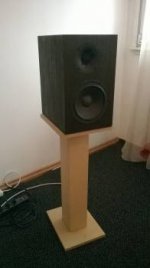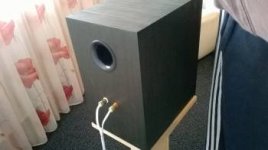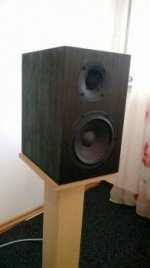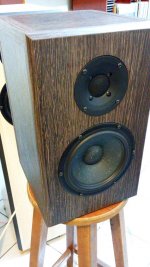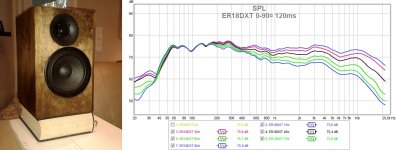Heavily stuffing a ported enclosure, with stuffing around the port will reduce the degree to which the port acts. If the end of the port (the end inside the cabinet) is free of any side walls or stuffing then it will work in an optimum fashion.
Stuffing a cabinet alone, be it ported, sealed, or whatever, will increase the effective volume of the cabinet and will alter the tuning frequency. I don't think you can really have too much stuffing unless it is interfering with a port or similar in a detrimental way. I had experimented briefly with stuffing small cabinets with huge amounts of stuffing, ie rolling the stuff up and literally squashing it down inside and the more stuffing I added the more volume the cabinet appeared to have. I think you'd really have to compact and squash down stuffing incredibly tightly to actually end up with a situation where the addition of more stuffing actually lowers the cabinet volume.
Stuffing a cabinet alone, be it ported, sealed, or whatever, will increase the effective volume of the cabinet and will alter the tuning frequency. I don't think you can really have too much stuffing unless it is interfering with a port or similar in a detrimental way. I had experimented briefly with stuffing small cabinets with huge amounts of stuffing, ie rolling the stuff up and literally squashing it down inside and the more stuffing I added the more volume the cabinet appeared to have. I think you'd really have to compact and squash down stuffing incredibly tightly to actually end up with a situation where the addition of more stuffing actually lowers the cabinet volume.
Heavily stuffing a ported enclosure, with stuffing around the port will reduce the degree to which the port acts. If the end of the port (the end inside the cabinet) is free of any side walls or stuffing then it will work in an optimum fashion.
Stuffing a cabinet alone, be it ported, sealed, or whatever, will increase the effective volume of the cabinet and will alter the tuning frequency. I don't think you can really have too much stuffing unless it is interfering with a port or similar in a detrimental way. I had experimented briefly with stuffing small cabinets with huge amounts of stuffing, ie rolling the stuff up and literally squashing it down inside and the more stuffing I added the more volume the cabinet appeared to have. I think you'd really have to compact and squash down stuffing incredibly tightly to actually end up with a situation where the addition of more stuffing actually lowers the cabinet volume.
http://www.nousaine.com/pdfs/Box Stuffing.pdf
Interesting article, it would appear that the smaller the box, the greater the stuffing density you can get away with. This might explain why I didn't appear to get negative going results with my very small boxes, which are less than 100cm².
re:"I have stuffed HEAVILY boxes with filler. I had nothing to loose but gained a lot more bass" - good result, but shows the box was too small to start with.... (&/or tuning too low)
Tandata, stuffing works. I will play next week a bit more with stuffing, just to see if reducing amount of polyfill before port will result in better high frequencies. I think I can release more of it. Anyway- my old arcam is the limiting factor.
PeteMck, indeed I have just a bit deeper enclosure and port was to specifications, and maybe it was the reason I had no proper bass.
PeteMck, indeed I have just a bit deeper enclosure and port was to specifications, and maybe it was the reason I had no proper bass.
Here's another.THX for an article link !
Volume filling a reflex box
In short, it is recommended, but don't put too much.
I think I should try to stuff more behind brace around port, keeping port open towards tweeter until middle brace- Bigger density there.
And before brace from drivers side use less stuffing but covering port ...
And before brace from drivers side use less stuffing but covering port ...
Apparently I made right decision using 3 dowels on every side of every joint, plus dowels for the brace ! I did not use any sound deadening sheets (once suggested to me), only damping sheets from europe audio.
Silicone along corners.
As well front and back baffles (25mm thickness, walls are 18mm) recessed (flush mounted ?) into enclosure.
Hopefully it will reduce resonances.
Weight is significant 😀
Silicone along corners.
As well front and back baffles (25mm thickness, walls are 18mm) recessed (flush mounted ?) into enclosure.
Hopefully it will reduce resonances.
Weight is significant 😀
My left speaker seems to be playing a bit, tiny bit louder.
Phase is ok
Stuffing levels checked, played- the same.
position swap, moving to different location- same
Any ideas ?
I can check power response but don't know how ...
Phase is ok
Stuffing levels checked, played- the same.
position swap, moving to different location- same
Any ideas ?
I can check power response but don't know how ...
My DIY build of these excelent speakers
Hello,
I just finished these speakers according to plan. I build enclosure from MDF. Sound is excellent. I enjoy them a lot.
Source path: Squeezebox receiver -> DAC with trofo output -> Pass buffer -> Class D based on IRS 2092 with SMPS 500W.
I highly recommend this design.
Hello,
I just finished these speakers according to plan. I build enclosure from MDF. Sound is excellent. I enjoy them a lot.
Source path: Squeezebox receiver -> DAC with trofo output -> Pass buffer -> Class D based on IRS 2092 with SMPS 500W.
I highly recommend this design.
Attachments
Long time since 2009...
...but this project is actual/current, and a good project survives the time test.
I made a version with the Zaph ZR71 dimensions (by "accident"), and I will check the response but I feel since the baffles are very similar, and since we have drivers with well-behaved integration probably ony a minor modification is needed.
Some impressions (with some conclusiuons but some things all people already knows

 ):
):
The sound are the most neutral and life-like at same time I have heard to date in a bookshelf with 2 way. For me is difficult to find a system neutral and vivid, resolute at same time; most "neutral" systems are depressingly boring and muffled or sometimes clinical or harsh.
Is clearly perceptible the great DXT dispersion and the very good integration between drivers. At proper volume setting, voices are very convincing when I walk along my home. Since this system have a so linear frequency response, it don't emphasizes certain things in recordings; all are here in correct proportions, except the bass, but this project excels in its own class, revealing the great ER driver linearity. One only notice the SEAS ER distorting with bass when it are making very large excursions...
Maximum clean volume is above average for this project type and again is a testament of driver's low non-linearity.
The DXT tweeter handles very well good power levels even with this low order crossover.
Maybe this remember a little the famous Grimm Audio LS-1 speaker, using same tweeter but other SEAS driver (8", magnesium cone). Reviewers says good things about it. Of course, a very different project but at least one or two targets in common: wide dispersion and exceptional frequency response, along others.
PS.: unfonately I err a little the tweeter diameter, and becomes off center when I attached it (the screws become slight off target). But the speaker recess are in perfect diameter.
...but this project is actual/current, and a good project survives the time test.
I made a version with the Zaph ZR71 dimensions (by "accident"), and I will check the response but I feel since the baffles are very similar, and since we have drivers with well-behaved integration probably ony a minor modification is needed.
Some impressions (with some conclusiuons but some things all people already knows
The sound are the most neutral and life-like at same time I have heard to date in a bookshelf with 2 way. For me is difficult to find a system neutral and vivid, resolute at same time; most "neutral" systems are depressingly boring and muffled or sometimes clinical or harsh.
Is clearly perceptible the great DXT dispersion and the very good integration between drivers. At proper volume setting, voices are very convincing when I walk along my home. Since this system have a so linear frequency response, it don't emphasizes certain things in recordings; all are here in correct proportions, except the bass, but this project excels in its own class, revealing the great ER driver linearity. One only notice the SEAS ER distorting with bass when it are making very large excursions...
Maximum clean volume is above average for this project type and again is a testament of driver's low non-linearity.
The DXT tweeter handles very well good power levels even with this low order crossover.
Maybe this remember a little the famous Grimm Audio LS-1 speaker, using same tweeter but other SEAS driver (8", magnesium cone). Reviewers says good things about it. Of course, a very different project but at least one or two targets in common: wide dispersion and exceptional frequency response, along others.
PS.: unfonately I err a little the tweeter diameter, and becomes off center when I attached it (the screws become slight off target). But the speaker recess are in perfect diameter.
Attachments
Last edited:
And strangely, about the "presence" sound, I found this "wow" factor before only in some fullranges or speakers with messed response (generally with HF rising response/"tilted up"), but it seems the wide disperion now is my personal preference to "ruler-flat" systems not sounding "flat boring"...
(I checked the response before completion at a test panel and seems to be perfectly OK, but my limited acoustical measurement gig maybe hide some gremlins to sight, and I consider only ~500Hz upwards).
(I checked the response before completion at a test panel and seems to be perfectly OK, but my limited acoustical measurement gig maybe hide some gremlins to sight, and I consider only ~500Hz upwards).
Interesting, very smooth dispersion and very good response even with cabinet change! Thanks for sharing the results.
I am very interested in the ER18DXT. Unfortunately, at present I will not be able to place them 2 feet from the walls, probably 1 foot at the most. My room is approximately 12 feet by 12 feet. Could anyone tell me if placement 1 foot from the wall would be so detrimental that I should look at another design?
If it makes a difference, my current speakers (Tekton Design 8.1T) are a similar design rear-ported two way and they seem fine close to the wall. Thank you
Rick
If it makes a difference, my current speakers (Tekton Design 8.1T) are a similar design rear-ported two way and they seem fine close to the wall. Thank you
Rick
No problem with near-wall placement. Actually it is much better than 3-4ft
Check this http://www.genelec.com/documents/publications/Monitor%20Placement%20in%20Small%20Rooms%20-%20Resolution%20July%20August%2009%20Supplement.pdf

Check this http://www.genelec.com/documents/publications/Monitor%20Placement%20in%20Small%20Rooms%20-%20Resolution%20July%20August%2009%20Supplement.pdf

- Home
- Loudspeakers
- Multi-Way
- Mark K's er18dxt
